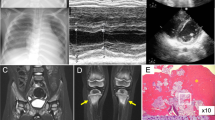Abstract
Autism spectrum disorder (ASD) affects an estimated 1 in 54 children aged 8 years in the United States (Maenner MJ, Shaw KA, Baio et al., 2020). For many of these children, there are concomitant eating and/or behavioral challenges that can make managing their nutritional health challenging. This commentary responds to a particularly challenging case in which a pediatric patient with ASD presented to the local hospital’s emergency department with severe weight loss and malnutrition.
Similar content being viewed by others
Notes
A pseudonym has been used and details of this case have been altered to protect the patient’s identity.
Indeed, by the time the hospital’s clinical ethics team was consulted, Levi had not received any medical treatment—not even a blood test or monitoring of his blood pressure—for several days, due to concerns that any attempts at medical intervention will cause him to resist, thereby causing harm to himself and/or staff members.
Option Two would involve sedation during the actual placement of the PEG tube. However, because this sedation had a discrete end point and would thus be temporary (lasting under an hour), we did not find it to be ethically fraught in the same way that a longer and indefinite period of sedation is. We found Levi’s initial diagnostic endoscopy morally unobjectionable for similar reasons—it involved a shorter (and much more predictable) use of sedation, and the fact that it was diagnostic, as opposed to therapeutic, meant that it had a clear endpoint. In addition, there was no real alternative to the diagnostic upper GI endoscopy that would allow the medical team to obtain the necessary medical information, and there was no feasible way to perform the diagnostic endoscopy without sedation. In contrast, there was a feasible alternative to sedating Levi for the therapeutic purpose of providing nutrition.
I am grateful to an anonymous reviewer at HEC Forum for making this point and pressing me to think more about the relationship between language and understanding in this case.
Again, I am grateful to an anonymous reviewer for this point.
References
AAP Committee on Bioethics. (2016). Informed consent in decision-making in pediatric practice. Pediatrics, 138(2), e20161484. https://doi.org/10.1542/peds.2016-1484.
Maenner, M. J., Shaw, K. A., Baio, J., et al. (2020). Prevalence of autism spectrum disorder among children aged 8 years—autism and developmental disabilities monitoring network, 11 sites, United States, 2016. MMWR Surveill Summ, 69(SS-4), 1–12. https://doi.org/10.15585/mmwr.ss6904a1.
Vohra, R., Madhavan, S., Sambamoorthi, U., & St Peter, C. (2014). Access to services, quality of care, and family impact for children with autism, other developmental disabilities, and other mental health conditions. Autism, 18(7), 815–826. https://doi.org/10.1177/1362361313512902.
Weerink, M. A. S., Struys, M., Hannivoort, L. N., Barends, C. R. M., Absalom, A. R., & Colin, P. (2017). Clinical pharmacokinetics and pharmacodynamics of dexmedetomidine. Clinical Pharmacokinetics, 56(8), 893–913. https://doi.org/10.1007/s40262-017-0507-7.
Acknowledgements
I am grateful to Lisa Campo-Engelstein, Wayne Shelton, and an anonymous reviewer at HEC Forum for helpful feedback on an earlier version of this paper.
Funding
None.
Author information
Authors and Affiliations
Corresponding author
Additional information
Publisher's Note
Springer Nature remains neutral with regard to jurisdictional claims in published maps and institutional affiliations.
Rights and permissions
About this article
Cite this article
Bunch, L. Forced Nutrition of a Pediatric Patient with Autism Spectrum Disorder. HEC Forum 33, 393–400 (2021). https://doi.org/10.1007/s10730-020-09418-4
Published:
Issue Date:
DOI: https://doi.org/10.1007/s10730-020-09418-4




